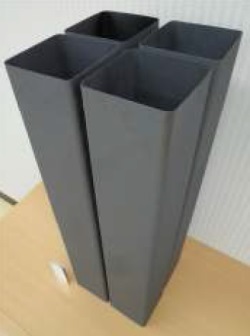New technology for the manufacture of nuclear fuel components from silicon carbide (SiC) has been developed by Japanese researchers. A prototype fuel assembly cover has already been fabricated and is awaiting trials.
 |
| The prototype fuel assembly cover (Image: Ibiden/Toshiba) |
The manufacturing technology for a SiC-based material for applications in nuclear power reactor cores has been developed by Toshiba Corp and electronics and ceramics company Ibiden.
Silicon carbide has been investigated in the development of accident-tolerant fuel, including as a replacement for Zircaloy cladding in light water reactors. With a melting point of 2730°C, it offers very high heat and oxidation resistance. It is already employed in TRISO-coated fuel particles, the type of fuel used in high temperature gas cooled reactors.
The new technology uses chemical vapour deposition, as well as optimized layer-formation equipment. The developers claim their manufacturing technology achieves SiC layer formation some 20 times faster than the conventional method. Such a faster manufacturing process has been considered necessary to enable the SiC composite to be made in production quantities, they said.
Toshiba and Ibiden have already fabricated a prototype fuel assembly cover using the new technology. The cover was produced using a composite material that consists of a continuous SiC fibre to provide reinforced strength. The fibre was formed into the shape of the fuel assembly cover using a machined mould.
Testing of the fuel assembly cover in a research reactor is set to begin in 2016. Toshiba and Ibiden aim to be able to offer the covers to operating nuclear power plants by around 2025.
The companies say their manufacturing technology can also be used to fabricate thin-walled, long cylinders from SiC composite. Such applications could include the production of fuel cladding tubes.
Toshiba and Ibiden developed their technology in collaboration with Nuclear Fuel Industries Ltd, the Research Centre for Advanced Science and Technology at the University of Tokyo and the Institute of Materials Research at Tohoku University.
Researched and written
by World Nuclear News




_18570.jpg)
_16159.jpg)
_18938.jpg)
_33584.jpg)





